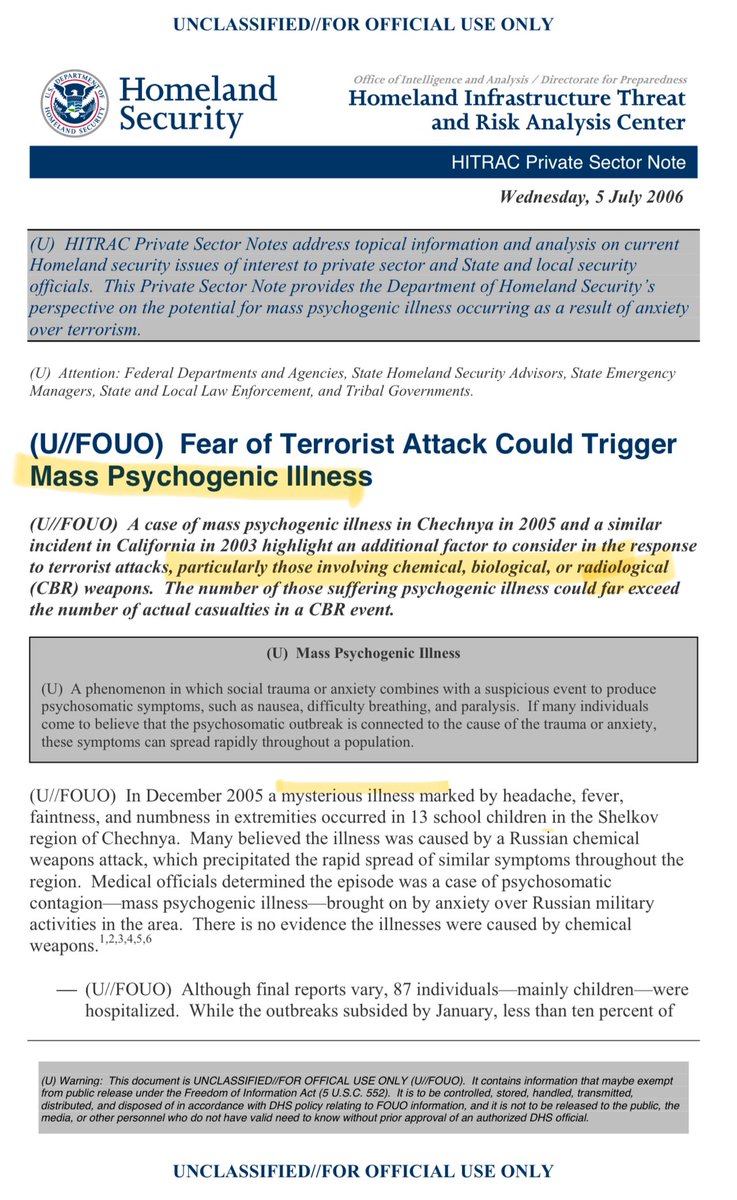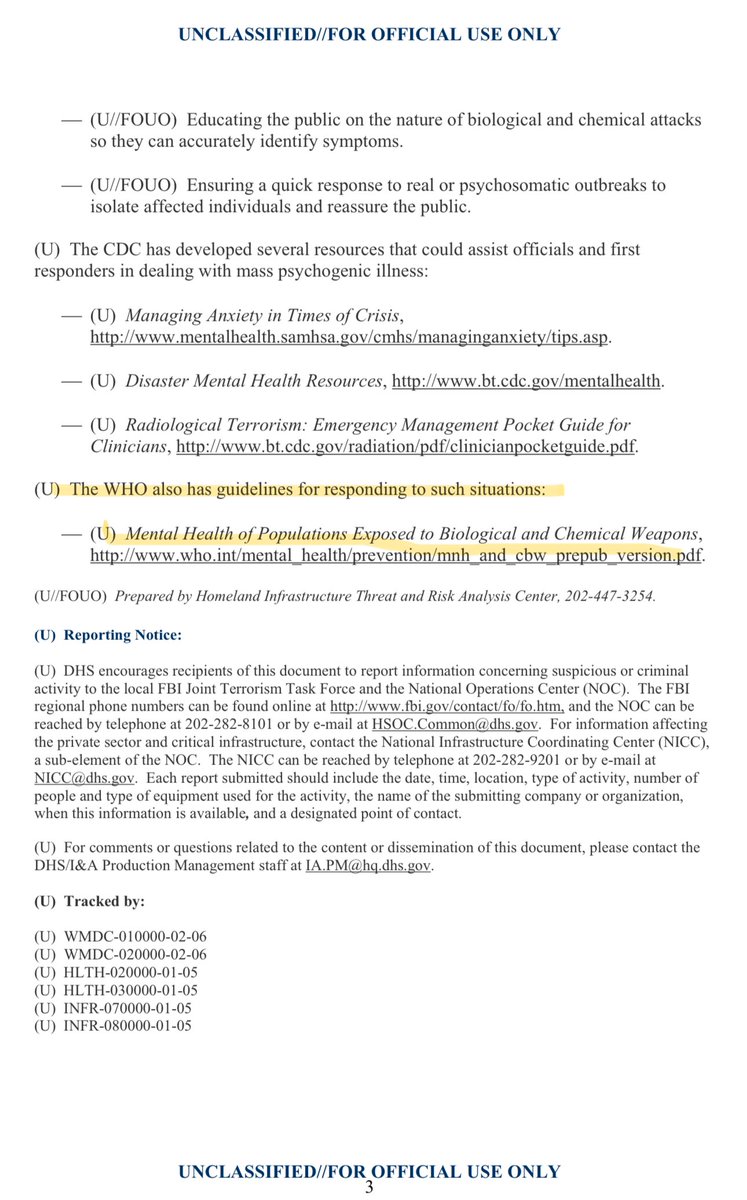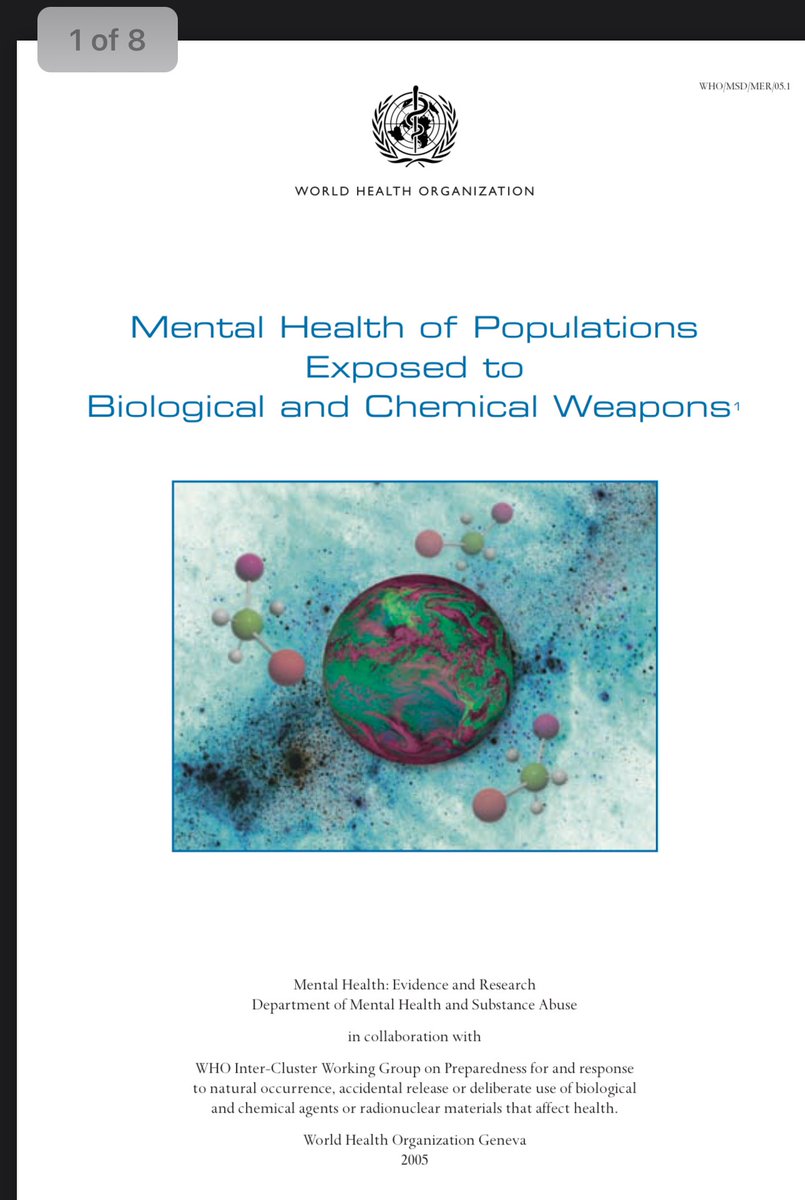A 2006 DHS document about the possibility of a “Mass Psychogenic Illness” they define as:
“A phenomenon in which social trauma or anxiety combines with a suspicious event to produce psychosomatic symptoms, such as nausea, difficulty breathing, and paralysis. If many individuals come to believe that the psychosomatic outbreak is connected to the cause of the trauma or anxiety, these symptoms can spread rapidly throughout a population.”
Particular focus is given to a CBR Event (chemical, biological, radiological).
“particularly those involving chemical, biological, or radiological (CBR) weapons. The number of those suffering psychogenic illness could far exceed the number of actual casualties in a CBR event.”
Some implications stated in the document:
“The observed symptoms of many mass psychogenic illness events are similar to several non-specific symptoms of possible chemical and biological weapons—including chemical agents, inhalational anthrax, and avian influenza.”
“Recent cases of mass psychogenic illness display a transferal of the symptoms onto contemporary anxieties.”


“A phenomenon in which social trauma or anxiety combines with a suspicious event to produce psychosomatic symptoms, such as nausea, difficulty breathing, and paralysis. If many individuals come to believe that the psychosomatic outbreak is connected to the cause of the trauma or anxiety, these symptoms can spread rapidly throughout a population.”
Particular focus is given to a CBR Event (chemical, biological, radiological).
“particularly those involving chemical, biological, or radiological (CBR) weapons. The number of those suffering psychogenic illness could far exceed the number of actual casualties in a CBR event.”
Some implications stated in the document:
“The observed symptoms of many mass psychogenic illness events are similar to several non-specific symptoms of possible chemical and biological weapons—including chemical agents, inhalational anthrax, and avian influenza.”
“Recent cases of mass psychogenic illness display a transferal of the symptoms onto contemporary anxieties.”



On the last page it links to a WHO Report entitled:
“Mental Health of Populations Exposed to Biological and Chemical Weapons”
I haven’t finished it but this 2005 document has some interesting language around fear and a variety of “interventions” to employ in the event of a psychogenic pandemic. It’s worth a look. Share any insights you might glean.
Report:
iris.who.int/bitstream/hand…
“Mental Health of Populations Exposed to Biological and Chemical Weapons”
I haven’t finished it but this 2005 document has some interesting language around fear and a variety of “interventions” to employ in the event of a psychogenic pandemic. It’s worth a look. Share any insights you might glean.
Report:
iris.who.int/bitstream/hand…

Straight from the WHO Report, keep in mind this is from 2005, they knew the psychological implications of declaring a “pandemic” and created the conditions to ramp up fear as much as possible. With the complicit media fanning the flames.
“The experience of fear in biological and chemical warfare Exposure to disasters or warfare is frightening to most persons. However, fear is even more likely when biological and chemical agents are involved. First, the most intimidating and terrifying component of biologi- cal and chemical warfare is that invisible agents are involved. In an explosion, people know immediately whether or not they have been injured. However, during biological warfare, people generally cannot rely on their own senses to determine physical exposure.
Second, fear and helplessness is increased when the agent can be spread by person-to-person contact creating a situation in which health providers, family, friends, and neighbours may be sources of illness. As a result, safe health care and social support may not be readily available at a time when they are needed most. The use of an agent that is contagious induces distressing problems, such as social stigma, isolation, and quaran- tine, including the separation of children from their parents, and fear of infecting loved ones. A chemically contaminated area may lead to the distressing experience of evacuation.
Third, the uncertainty of the extent of dangerousness of biological and chemical weapons enhances fear. Because many agents are rarely encountered, there may be a lack of clarity among professionals about who is at risk of infection, how to reliably detect cases (generating myriad of ‘false positive’ assessments), what the health consequences might be, and how to manage the crisis. The expression of conflicting expert opinions and changing public health recommendations are likely to enhance public anxiety. Fourth, persons may misattribute signs of autonomic arousal as evidence of infection or contamination. Sign and symptoms of autonomic arousal are normal among frightened persons and involve various systems and organs and include muscle tension, palpitations, hyperventilation, vomiting, sweating, tremors, and a sense of foreboding. Thus frightened, physically healthy individuals experiencing symptoms of autonomic arousal may mistakenly attribute the physical sensations to infection or contamination and may overwhelm health services.
Fifth, persons wearing protective clothing, masks, and respirators may experience great distress due to: heat and breathing stress, claustrophobic effects (so-called gas mask phobia), potential impairment in verbal com- munication, and reduction in physical functioning to perform tasks perceived to be necessary for survival.
Despite high public fear and uncertainty, historical accounts of chemical and biological attacks suggest that public panic is rare. Public panic occurs only when there are inadequate exits in confined places (e.g., in stadi- ums) or perceptions of limited access to essential, life-saving health services.”
“The experience of fear in biological and chemical warfare Exposure to disasters or warfare is frightening to most persons. However, fear is even more likely when biological and chemical agents are involved. First, the most intimidating and terrifying component of biologi- cal and chemical warfare is that invisible agents are involved. In an explosion, people know immediately whether or not they have been injured. However, during biological warfare, people generally cannot rely on their own senses to determine physical exposure.
Second, fear and helplessness is increased when the agent can be spread by person-to-person contact creating a situation in which health providers, family, friends, and neighbours may be sources of illness. As a result, safe health care and social support may not be readily available at a time when they are needed most. The use of an agent that is contagious induces distressing problems, such as social stigma, isolation, and quaran- tine, including the separation of children from their parents, and fear of infecting loved ones. A chemically contaminated area may lead to the distressing experience of evacuation.
Third, the uncertainty of the extent of dangerousness of biological and chemical weapons enhances fear. Because many agents are rarely encountered, there may be a lack of clarity among professionals about who is at risk of infection, how to reliably detect cases (generating myriad of ‘false positive’ assessments), what the health consequences might be, and how to manage the crisis. The expression of conflicting expert opinions and changing public health recommendations are likely to enhance public anxiety. Fourth, persons may misattribute signs of autonomic arousal as evidence of infection or contamination. Sign and symptoms of autonomic arousal are normal among frightened persons and involve various systems and organs and include muscle tension, palpitations, hyperventilation, vomiting, sweating, tremors, and a sense of foreboding. Thus frightened, physically healthy individuals experiencing symptoms of autonomic arousal may mistakenly attribute the physical sensations to infection or contamination and may overwhelm health services.
Fifth, persons wearing protective clothing, masks, and respirators may experience great distress due to: heat and breathing stress, claustrophobic effects (so-called gas mask phobia), potential impairment in verbal com- munication, and reduction in physical functioning to perform tasks perceived to be necessary for survival.
Despite high public fear and uncertainty, historical accounts of chemical and biological attacks suggest that public panic is rare. Public panic occurs only when there are inadequate exits in confined places (e.g., in stadi- ums) or perceptions of limited access to essential, life-saving health services.”
• • •
Missing some Tweet in this thread? You can try to
force a refresh

















